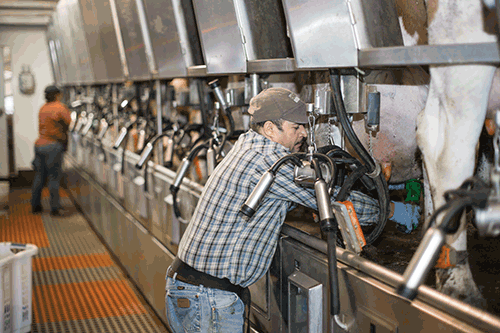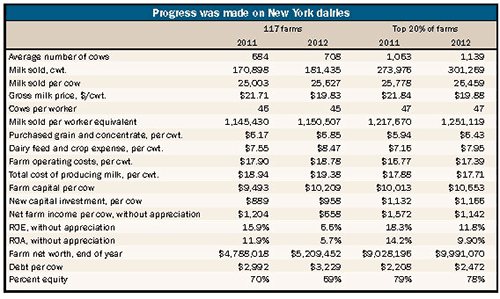The authors are with Cornell University PRO-DAIRY Program.

The top 20 percent of herds saw gains in labor efficiency, milk sales and herd size.
Change in the financial performance of dairies from one year to the next has been a constant for decades. The variability in earnings, driven by an array of factors, challenges farm managers on decisions they make and how they analyze their business over time.
While there is value gained when comparing to averages, additional value is obtained by looking at how the individual business changed and comparing that to farm plans, goals and how the industry changed over the same time frame.
One program that is used to evaluate farm performance over time in New York and other parts of the country is the Cornell Dairy Farm Business Summary and Analysis program. In 2012, over 150 dairies voluntarily completed a Dairy Farm Business Summary (DFBS).To help look at the question of industry wide change, 117 farms that participated in the DFBS in both 2011 and 2012 were compared. The table reflects selected measures for these 117 farms, along with the top 20 percent of farms as sorted by ROA (return on assets) without appreciation.
Earnings and profitability fell
Net farm income per cow, defined as the return to the family for their labor, management and equity capital, without appreciation, fell 45 percent across the 117 farms. Return on equity capital went down to 6.6 percent, and return on all capital fell to 5.7 percent. While this was a significant drop in profitability, returns were still positive and met the long-term goal of beating inflation rates.
For the top 20 percent of farms, earnings shrunk at a slower rate, with net farm income per cow falling 27.4 percent and the rate of return on equity falling to 11.8 percent.
Key management questions: What are your profit levels, and how much did they change from the previous year? Over time, are you meeting the minimum goal for return on equity and return to all capital?
Costs of making milk
The average farm grew its herd size by 24 cows to 708 milking and dry cows. This, coupled with a 2.5 percent gain in milk sold per cow, led to a 6.2 percent boost in total milk shipped for the year. The top 20 percent of farms raised milk shipped by 10 percent, driven by a 7.1 percent rise in herd size and a 2.6 percent hike in milk sold per cow.
The average gross milk price for these 117 farms was $19.83 per hundredweight (cwt.), $1.88 per cwt. less than 2011. All other sources of revenue, including cull cow sales, crop sales and change in grown inventories, grew by 72 cents to $3.16 per cwt. The top 20 percent of farms averaged $19.88 per cwt. for gross milk price, a drop of $1.96 from 2011. All other sources of revenue rose by 95 cents to $3.49 per cwt.
Operating costs to run the farm elevated 4.9 percent to $18.78 per cwt. Purchased grain and concentrate costs, too, rose 68 cents per cwt. Total costs to produce milk, including return to the family for their labor, management and equity capital boosted 44 cents to $19.38.
The top 20 percent of farms again increased costs at a slower rate, with farm operating costs rising 62 cents per cwt., and total costs to produce milk dropping 17 cents per cwt. Total costs to produce milk are those expenses that have to be covered by the sale of milk only.
Key management questions: How much did your milk shipped off the farm change, what were the driving factors behind this and why? What are your costs to operate the farm and your total costs to produce milk? If it changed faster or slower than the industry trend, why?
Efficiency and investment a focus
Number of worker equivalents (2,760 hours of labor equals one annual worker equivalent) rose by 5.7 percent. This boost was faster than the growth in cow numbers, leading to a decrease in cows per worker. However, with 2.5 percent gain in milk sold per cow, milk sold per worker bolstered slightly.
The top 20 percent of farms maintained the same cows per worker, with the rise in milk sold per cow leading to a gain of 2.7 percent in milk sold per worker. This improvement in labor efficiency offset the faster elevation in cost per worker for the top 20 percent of farms.
Both groups of farms continued to make reinvestments into their businesses. The 117 farms invested $958 per cow in 2012, increasing the total capital per cow to $10,209, a rise of $716. The top 20 percent of farms invested $1,166 in 2012, with capital per cow elevating $640 per cow to $10,653. While the top 20 percent of farms invested more total capital, the faster growth in cow numbers led to a slower rise in the total capital per cow.
Key management questions: How did your labor efficiency and labor costs change? How much capital has been reinvested in your farm over the last year, and what has this reinvestment positioned your business to do?
Financial position grew
Net worth or equity position continued to grow on these 117 farms. Total farm equity rose 8.8 percent to over $5.2 million with percent equity falling to 69 percent. Farm debt per cow climbed by $307 or 10 percent from 2011 to 2012.
The top 20 percent of farms gained in net worth 10.7 percent, while showing a 1 percentage point drop in percent equity to 78 percent. Debt per cow rose 12 percent to $2,472. It should be noted that this change in debt came from capital reinvestment.

This article appears on page 637 of the October 10, 2013 issue of Hoard's Dairyman.

Change in the financial performance of dairies from one year to the next has been a constant for decades. The variability in earnings, driven by an array of factors, challenges farm managers on decisions they make and how they analyze their business over time.
While there is value gained when comparing to averages, additional value is obtained by looking at how the individual business changed and comparing that to farm plans, goals and how the industry changed over the same time frame.
One program that is used to evaluate farm performance over time in New York and other parts of the country is the Cornell Dairy Farm Business Summary and Analysis program. In 2012, over 150 dairies voluntarily completed a Dairy Farm Business Summary (DFBS).To help look at the question of industry wide change, 117 farms that participated in the DFBS in both 2011 and 2012 were compared. The table reflects selected measures for these 117 farms, along with the top 20 percent of farms as sorted by ROA (return on assets) without appreciation.
Earnings and profitability fell
Net farm income per cow, defined as the return to the family for their labor, management and equity capital, without appreciation, fell 45 percent across the 117 farms. Return on equity capital went down to 6.6 percent, and return on all capital fell to 5.7 percent. While this was a significant drop in profitability, returns were still positive and met the long-term goal of beating inflation rates.
For the top 20 percent of farms, earnings shrunk at a slower rate, with net farm income per cow falling 27.4 percent and the rate of return on equity falling to 11.8 percent.
Key management questions: What are your profit levels, and how much did they change from the previous year? Over time, are you meeting the minimum goal for return on equity and return to all capital?
Costs of making milk
The average farm grew its herd size by 24 cows to 708 milking and dry cows. This, coupled with a 2.5 percent gain in milk sold per cow, led to a 6.2 percent boost in total milk shipped for the year. The top 20 percent of farms raised milk shipped by 10 percent, driven by a 7.1 percent rise in herd size and a 2.6 percent hike in milk sold per cow.
The average gross milk price for these 117 farms was $19.83 per hundredweight (cwt.), $1.88 per cwt. less than 2011. All other sources of revenue, including cull cow sales, crop sales and change in grown inventories, grew by 72 cents to $3.16 per cwt. The top 20 percent of farms averaged $19.88 per cwt. for gross milk price, a drop of $1.96 from 2011. All other sources of revenue rose by 95 cents to $3.49 per cwt.
Operating costs to run the farm elevated 4.9 percent to $18.78 per cwt. Purchased grain and concentrate costs, too, rose 68 cents per cwt. Total costs to produce milk, including return to the family for their labor, management and equity capital boosted 44 cents to $19.38.
The top 20 percent of farms again increased costs at a slower rate, with farm operating costs rising 62 cents per cwt., and total costs to produce milk dropping 17 cents per cwt. Total costs to produce milk are those expenses that have to be covered by the sale of milk only.
Key management questions: How much did your milk shipped off the farm change, what were the driving factors behind this and why? What are your costs to operate the farm and your total costs to produce milk? If it changed faster or slower than the industry trend, why?
Efficiency and investment a focus
Number of worker equivalents (2,760 hours of labor equals one annual worker equivalent) rose by 5.7 percent. This boost was faster than the growth in cow numbers, leading to a decrease in cows per worker. However, with 2.5 percent gain in milk sold per cow, milk sold per worker bolstered slightly.
The top 20 percent of farms maintained the same cows per worker, with the rise in milk sold per cow leading to a gain of 2.7 percent in milk sold per worker. This improvement in labor efficiency offset the faster elevation in cost per worker for the top 20 percent of farms.
Both groups of farms continued to make reinvestments into their businesses. The 117 farms invested $958 per cow in 2012, increasing the total capital per cow to $10,209, a rise of $716. The top 20 percent of farms invested $1,166 in 2012, with capital per cow elevating $640 per cow to $10,653. While the top 20 percent of farms invested more total capital, the faster growth in cow numbers led to a slower rise in the total capital per cow.
Key management questions: How did your labor efficiency and labor costs change? How much capital has been reinvested in your farm over the last year, and what has this reinvestment positioned your business to do?
Financial position grew
Net worth or equity position continued to grow on these 117 farms. Total farm equity rose 8.8 percent to over $5.2 million with percent equity falling to 69 percent. Farm debt per cow climbed by $307 or 10 percent from 2011 to 2012.
The top 20 percent of farms gained in net worth 10.7 percent, while showing a 1 percentage point drop in percent equity to 78 percent. Debt per cow rose 12 percent to $2,472. It should be noted that this change in debt came from capital reinvestment.






